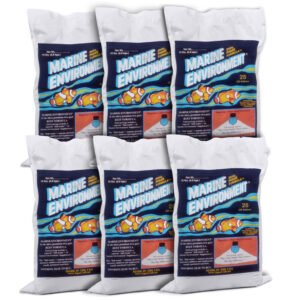
Blue-Stripe Angelfish Chaetodontplus septertrionalis
| The Blue-Stripe Angelfish (Chaetodontplus septertrionalis) is found in the South China Sea. It is usually collected south of Taiwan and north of the Philippine Islands. This exotic angelfish grows to about 8″.
In nature the blue-stripe angelfish can be found in the company of butterfly fish, wrasses and other angelfish. It is constantly nibbling at or eating a variety of foods that include: crustaceans, alga and coral polyps. Large numbers of blue-stripe angles were collected up to the late 1980’s. After that, limited numbers were collected. Some reasons for a reduced supply are: A) Traditional collecting sites were fished out and divers had to go further away to discover new areas to collect. B) Other types of fish collected with the blue-stripe angel can be collected from other areas and shipped at lower costs. Some of these other fish are: butterfly, wrasses and other angelfish from the Philippines and Hawaii. With increased difficulty in collecting and the refusal to receive other fish from the same area, the price increased. The result is that only the blue-stripe angel is in demand from this part of the world. With higher prices to import only one type of fish, this created a situation where the once plentiful blue-stripe angel is now relatively rare. In 1993 only a few hundred blue-stripe angelfish were collected and shipped to aquarists around the world. If you are fortunate enough to find a healthy blue-stripe angel that is taking a variety of foods at your pet show, consider this as a valuable addition to your marine aquariums. The blue-stripe angel goes through several color changes from juvenile to adolescent to adult markings. The young blue-stripe angel (under 1 1/2″) is mostly dark gray in color with a yellow vertical band just behind the eyes, a little yellow on the nose and a clear tail. The adolescent blue-stripe angel (about 2″ to 3″) begins to show blue horizontal stripes on the tan to brown body. At this time the yellow body band starts to disappear and the tail starts to turn yellow. The adult blue-stripe angel (about 4 1/2″ and larger) shows a dramatic golden brown body with neon blue horizontal stripes. The yellow body band is gone and the tail develops a yellow color. In a well operating home marine aquarium this complete color changes from juvenile to adult can take place in about 8 to 12 months. The blue-stripe angel is a valuable addition to most marine aquariums. When juvenile, it is shy and requires hiding places. When adolescent, it becomes more comfortable with a variety of tank mates. When adult, it is not usually aggressive and will mix well with a variety of other captive marine fish. Like all other new fish you acquire, the blue-stripe angel should be held in a QUARANTINE for a minimum of 30 days, prior to introduction to your display aquarium. The blue-stripe angel will do best in an established tank with a variety of algae and corals. Always create a captive environment which duplicates the part of nature where your pets come from. Like all other animals you keep, avoid adding pets into a tank with large or aggressive tank mates. In captivity, the blue-stripe angelfish will accept a variety of foods. A good starter food could be live brine shrimp. Be sure live foods are healthy and come from clean water. It is best to wash live foods with clean fresh water before adding to your display aquarium. Other foods to feed the blue-stripe angel are high quality flake foods, such as Tetra Marin®, minced fresh scallop and/or prawn with algae. There are many frozen foods available at better pet shops. However, it is always best to make your own frozen foods by using freshly minced scallops, prawns or clams that have been cleaned thoroughly and frozen with MARINE VITA-PEP™ or Coral Reef & Marine Fish Vitamins™. |
